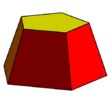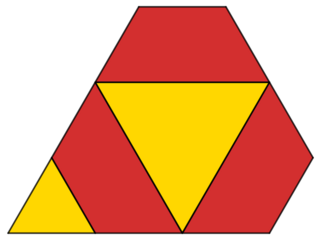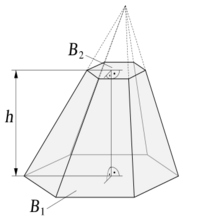Frustum
| Set of pyramidal right n-gonal frustums | |
|---|---|
  Examples: right pentagonal and square frustums (n = 5 and n = 4) | |
| Faces | n isosceles trapezoids, 2 regular n-gons |
| Edges | 3n |
| Vertices | 2n |
| Symmetry group | Cnv, [1,n], (*nn) |
| Dual polyhedron | convex asymmetric right n-gonal bipyramid |
| Properties | convex |
| Net | |
 | |
In geometry, a frustum for 'morsel';[lower-alpha 1] (pl.: frusta or frustums) is the portion of a solid (normally a pyramid or a cone) that lies between two parallel planes cutting the solid. In the case of a pyramid, the base faces are polygonal and the side faces are trapezoidal. A right frustum is a right pyramid or a right cone truncated perpendicularly to its axis;[3] otherwise, it is an oblique frustum. In a truncated cone or truncated pyramid, the truncation plane is not necessarily parallel to the cone's base, as in a frustum. If all its edges are forced to become of the same length, then a frustum becomes a prism (possibly oblique or/and with irregular bases).

A frustum's axis is that of the original cone or pyramid. A frustum is circular if it has circular bases; it is right if the axis is perpendicular to both bases, and oblique otherwise.
The height of a frustum is the perpendicular distance between the planes of the two bases.
Cones and pyramids can be viewed as degenerate cases of frusta, where one of the cutting planes passes through the apex (so that the corresponding base reduces to a point). The pyramidal frusta are a subclass of prismatoids.
Two frusta with two congruent bases joined at these congruent bases make a bifrustum.
Formulas
Volume
The formula for the volume of a pyramidal square frustum was introduced by the ancient Egyptian mathematics in what is called the Moscow Mathematical Papyrus, written in the 13th dynasty (c. 1850 BC):
- [math]\displaystyle{ V = \frac{h}{3}\left(a^2 + ab + b^2\right), }[/math]
where a and b are the base and top side lengths, and h is the height.
The Egyptians knew the correct formula for the volume of such a truncated square pyramid, but no proof of this equation is given in the Moscow papyrus.
The volume of a conical or pyramidal frustum is the volume of the solid before slicing its "apex" off, minus the volume of this "apex":
- [math]\displaystyle{ V = \frac{h_1 B_1 - h_2 B_2}{3}, }[/math]
where B1 and B2 are the base and top areas, and h1 and h2 are the perpendicular heights from the apex to the base and top planes.
Considering that
- [math]\displaystyle{ \frac{B_1}{h_1^2} = \frac{B_2}{h_2^2} = \frac{\sqrt{B_1B_2}}{h_1h_2} = \alpha, }[/math]
the formula for the volume can be expressed as the third of the product of this proportionality, [math]\displaystyle{ \alpha }[/math], and of the difference of the cubes of the heights h1 and h2 only:
- [math]\displaystyle{ V = \frac{h_1 \alpha h_1^2 - h_2 \alpha h_2^2}{3} = \alpha\frac{h_1^3 - h_2^3}{3}. }[/math]
By using the identity a3 − b3 = (a − b)(a2 + ab + b2), one gets:
- [math]\displaystyle{ V = (h_1 - h_2)\alpha\frac{h_1^2 + h_1h_2 + h_2^2}{3}, }[/math]
where h1 − h2 = h is the height of the frustum.
Distributing [math]\displaystyle{ \alpha }[/math] and substituting from its definition, the Heronian mean of areas B1 and B2 is obtained:
- [math]\displaystyle{ \frac{B_1 + \sqrt{B_1B_2} + B_2}{3}; }[/math]
the alternative formula is therefore:
- [math]\displaystyle{ V = \frac{h}{3}\left(B_1 + \sqrt{B_1B_2} + B_2\right). }[/math]
Heron of Alexandria is noted for deriving this formula, and with it, encountering the imaginary unit: the square root of negative one.[4]
In particular:
- The volume of a circular cone frustum is:
- [math]\displaystyle{ V = \frac{\pi h}{3}\left(r_1^2 + r_1r_2 + r_2^2\right), }[/math]
- where r1 and r2 are the base and top radii.
- The volume of a pyramidal frustum whose bases are regular n-gons is:
- [math]\displaystyle{ V = \frac{nh}{12}\left(a_1^2 + a_1a_2 + a_2^2\right)\cot\frac{\pi}{n}, }[/math]
- where a1 and a2 are the base and top side lengths.
Surface area
File:Tronco cono 3D.stl For a right circular conical frustum[5][6]
- [math]\displaystyle{ \begin{align}\text{Lateral surface area}&=\pi\left(r_1+r_2\right)s\\ &=\pi\left(r_1+r_2\right)\sqrt{\left(r_1-r_2\right)^2+h^2}\end{align} }[/math]
and
- [math]\displaystyle{ \begin{align}\text{Total surface area}&=\pi\left(\left(r_1+r_2\right)s+r_1^2+r_2^2\right)\\ &=\pi\left(\left(r_1+r_2\right)\sqrt{\left(r_1-r_2\right)^2+h^2}+r_1^2+r_2^2\right)\end{align} }[/math]
where r1 and r2 are the base and top radii respectively, and s is the slant height of the frustum.
The surface area of a right frustum whose bases are similar regular n-sided polygons is
- [math]\displaystyle{ A= \frac{n}{4}\left[\left(a_1^2+a_2^2\right)\cot \frac{\pi}{n} + \sqrt{\left(a_1^2-a_2^2\right)^2\cot^2 \frac{\pi}{n}+4 h^2\left(a_1+a_2\right)^2} \right] }[/math]
where a1 and a2 are the sides of the two bases.
Examples
- On the back (the reverse) of a United States one-dollar bill, a pyramidal frustum appears on the reverse of the Great Seal of the United States, surmounted by the Eye of Providence.
- Ziggurats, step pyramids, and certain ancient Native American mounds also form the frustum of one or more pyramids, with additional features such as stairs added.
- Chinese pyramids.
- The John Hancock Center in Chicago , Illinois is a frustum whose bases are rectangles.
- The Washington Monument is a narrow square-based pyramidal frustum topped by a small pyramid.
- The viewing frustum in 3D computer graphics is a virtual photographic or video camera's usable field of view modeled as a pyramidal frustum.
- In the English translation of Stanislaw Lem's short-story collection The Cyberiad, the poem Love and tensor algebra claims that "every frustum longs to be a cone".
- Buckets and typical lampshades are everyday examples of conical frustums.
- Drinking glasses and some space capsules are also some examples.
- Garsų Gaudyklė wooden structure or statue in Lithuania.
- Valençay cheese
- Rolo candies
See also
- Spherical frustum
Notes
- ↑ The term frustum comes from la frustum, meaning 'piece' or 'morsel". The English word is often misspelled as frustrum, a different Latin word cognate to the English word "frustrate".[1] The confusion between these two words is very old: a warning about them can be found in the Appendix Probi, and the works of Plautus include a pun on them.[2]
References
- ↑ Clark, John Spencer (1895). Teachers' Manual: Books I–VIII. For Prang's complete course in form-study and drawing, Books 7–8. Prang Educational Company. p. 49. https://books.google.com/books?id=83EBAAAAYAAJ&pg=PA49.
- ↑ Fontaine, Michael (2010). Funny Words in Plautine Comedy. Oxford University Press. pp. 117, 154. ISBN 9780195341447. https://books.google.com/books?id=SFPUvjlSUIsC&pg=PA117.
- ↑ Kern, William F.; Bland, James R. (1938). Solid Mensuration with Proofs. p. 67.
- ↑ Nahin, Paul. An Imaginary Tale: The story of √−1. Princeton University Press. 1998
- ↑ "Mathwords.com: Frustum". http://www.mathwords.com/f/frustum.htm.
- ↑ Al-Sammarraie, Ahmed T.; Vafai, Kambiz (2017). "Heat transfer augmentation through convergence angles in a pipe". Numerical Heat Transfer, Part A: Applications 72 (3): 197−214. doi:10.1080/10407782.2017.1372670. Bibcode: 2017NHTA...72..197A.
External links
- Derivation of formula for the volume of frustums of pyramid and cone (Mathalino.com)
- Weisstein, Eric W.. "Pyramidal frustum". http://mathworld.wolfram.com/PyramidalFrustum.html.
- Weisstein, Eric W.. "Conical frustum". http://mathworld.wolfram.com/ConicalFrustum.html.
- Paper models of frustums (truncated pyramids)
- Paper model of frustum (truncated cone)
- Design paper models of conical frustum (truncated cones)
 |






